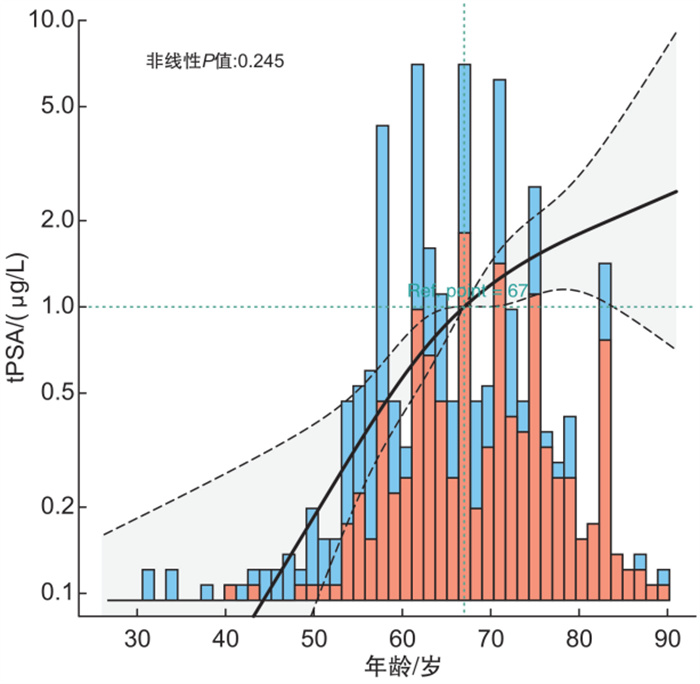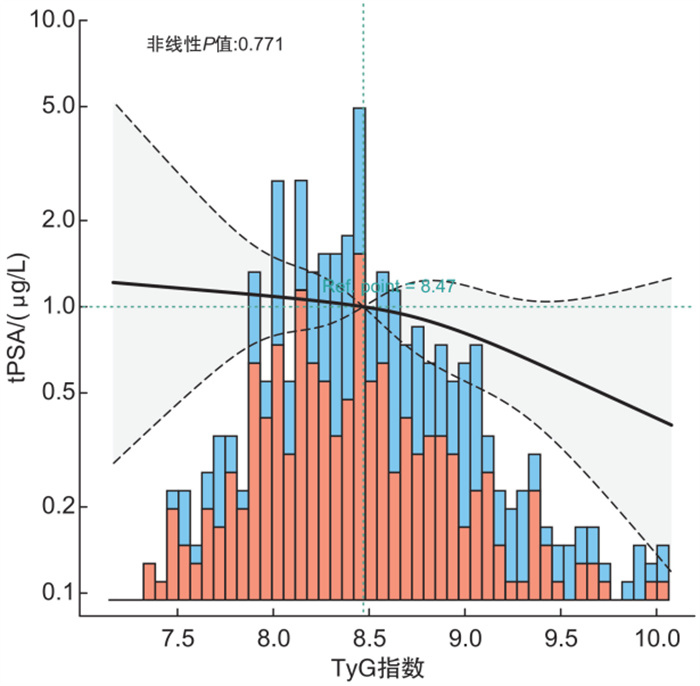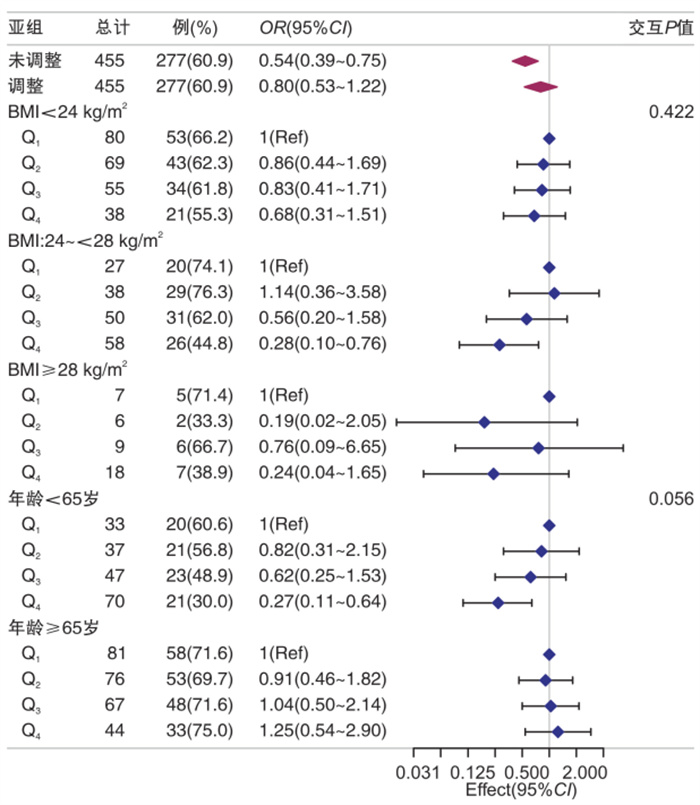Association between age, TyG index and serum tPSA in patients with benign prostatic hyperplasia
-
摘要: 目的 探讨甘油三酯-葡萄糖(triglyceride-glucose,TyG)指数与良性前列腺增生(benign prostatic hyperplasia,BPH)患者血清总前列腺特异性抗原(total prostate-specific antigen,tPSA)之间的关系。 方法 将血清tPSA按照是否≥1.6 μg/L进行分组,运用logistic单因素、多因素分析455例北京中医药大学东直门医院厦门医院BPH患者TyG指数、年龄、体重指数(BMI)、相关生化指标与tPSA的相关性。 结果 单因素分析提示tPSA≥1.6 μg/L与年龄呈正相关,与甘油三酯、谷丙转氨酶、总胆固醇、TyG指数呈负相关。多因素分析中模型2调整了年龄、BMI,模型3在模型2基础上调整了低密度脂蛋白胆固醇后tPSA与TyG指数仍呈负相关,亚组分析结果仍稳健,无明显交互作用。 结论 年龄、TyG指数对BPH患者血清tPSA有一定影响,年龄是tPSA≥1.6 μg/L的危险因素,而TyG指数是tPSA≥1.6 μg/L的保护因素,临床上在评估血清tPSA水平时应当考虑年龄、TyG指数的影响。
-
关键词:
- 年龄 /
- 甘油三酯-葡萄糖指数 /
- 良性前列腺增生 /
- 血清总前列腺特异性抗原 /
- 横断面研究
Abstract: Objective To investigate the association between the triglyceride-glucose(TyG) index and total prostate-specific antigen(tPSA) in the serum of patients with benign prostatic hyperplasia(BPH). Methods The study grouped serum tPSA based on whether it was ≥1.6 μg/L. Logistic univariate and multivariate analyses were used to assess the correlation between TyG index, age, BMI, other related biochemical indicators and tPSA in 455 patients with BPH. Results Univariate analysis snggested that tPSA≥1.6 μg/L was positively correlated with age and negatively correlated with triglycerides, glutamic-pyruvic transaminase, total cholesterol, and TyG index. In the multivariate analysis, Model 2 adjusted for age and BMI, and Model 3 adjusted low-density lipoprotein cholesterol based on Model 2. After these adjustments, tPSA still showed a negative correlation with TyG index, and the results of the subgroup analysis remained robust with no significant interaction. Conclusion Age and the TyG index have a certain impact on serum tPSA levels in patients with BPH. Clinically, the influence of age and TyG index should be considered when evaluating serum tPSA levels. -

-
表 1 2组患者年龄、BMI、生化指标比较
例(%),X±S 项目 总例数(455例) tPSA<1.6 μg/L组(178例) tPSA≥1.6 μg/L组(277例) P值 年龄/岁 <0.001 ≤65 187(41.1) 102(57.3) 85(30.7) >65 268(58.9) 76(42.7) 192(69.3) BMI/(kg/m2) 0.327 <24 242(53.2) 91(51.1) 151(54.5) 24~<28 173(38.0) 67(37.6) 106(38.3) ≥28 40(8.8) 20(11.2) 20(7.2) 生化指标 FPG/(mmol/L) 5.7±1.8 5.7±1.6 5.7±1.9 0.998 TG/(mmol/L) 1.3±0.8 1.5±1.0 1.2±0.7 <0.001 ALT/(U/L) 22.9±18.7 25.9±21.0 21.0±16.8 0.006 CHOL/(mmol/L) 4.9±1.3 5.1±1.3 4.8±1.3 0.022 LDL-C/(mmol/L) 3.2±1.0 3.3±0.9 3.2±1.0 0.093 HDL-C/(mmol/L) 1.3±0.3 1.2±0.3 1.3±0.3 0.632 Cr/(μmol/L) 91.3±50.7 85.5±29.9 95.1±60.2 0.053 AST/(U/L) 27.3±46.6 25.6±12.6 28.4±58.8 0.519 TyG指数 8.5±0.6 8.7±0.6 8.5±0.5 <0.001 表 2 tPSA≥1.6 μg/L单因素分析
项目 OR(95%CI) P值 年龄>65岁 3.03(2.05~4.49) <0.001 BMI 24~<28 kg/m2 0.95(0.64~1.42) 0.816 BMI≥28 kg/m2 0.61(0.31~1.18) 0.140 FPG 1.01(0.91~1.11) 0.998 TG 0.59(0.46~0.77) <0.001 ALT 0.99(0.97~1.01) 0.010 CHOL 0.84(0.72~0.98) 0.023 LDL-C 0.85(0.71~1.03) 0.094 HDL-C 1.15(0.65~2.03) 0.631 Cr 1.01(0.99~1.01) 0.059 AST 1.01(0.99~1.01) 0.539 TyG指数 0.54(0.39~0.75) <0.001 表 3 TyG指数与tPSA≥1.6 μg/L多因素分析
TyG指数 例数 例(%) 模型1 模型2 模型3 95%CI P值 95%CI P值 95%CI P值 Q1 114 78(68.4) 1(Ref) 1(Ref) 1(Ref) Q2 113 74(65.5) 0.88(0.5~1.52) 0.638 0.89(0.5~1.57) 0.677 0.89(0.5~1.58) 0.692 Q3 114 71(62.3) 0.76(0.44~1.32) 0.330 0.82(0.46~1.45) 0.492 0.82(0.46~1.46) 0.503 Q4 114 54(47.4) 0.42(0.24~0.71) 0.001 0.53(0.29~0.94) 0.031 0.53(0.3~0.96) 0.036 P趋势 0.001 0.033 0.038 -
[1] Zou BZ, Wen H, Luo HJ, et al. Value of serum free prostate-specific antigen density in the diagnosis of prostate cancer[J]. Ir J Med Sci, 1971, 2023, 192(6): 2681-2687.
[2] 杜林, 王曼丽, 左林. 前列腺特异性抗原检测用于诊断早期前列腺增生的价值[J]. 中国社区医师, 2023, 39(16): 107-109. https://www.cnki.com.cn/Article/CJFDTOTAL-XCYS202316035.htm
[3] Wei CC, Tian L, Jia B, et al. Association between serum triglycerides and prostate specific antigen(PSA)among U.S. males: national health and nutrition examination survey(NHANES), 2003-2010[J]. Nutrients, 2022, 14(7): 1325. doi: 10.3390/nu14071325
[4] Liu ZC, Chen C, Yu FX, et al. Association of total dietary intake of sngars with prostate-specific antigen(PSA)concentrations: evidence from the national health and nutrition examination survey(NHANES), 2003-2010[J]. Biomed Res Int, 2021, 2021: 4140767.
[5] Loprinzi PD, Kohli M. Effect of physical activity and sedentary behavior on serum prostate-specific antigen concentrations: results from the National Health and Nutrition Examination Survey(NHANES), 2003-2006[J]. Mayo Clin Proc, 2013, 88(1): 11-21. doi: 10.1016/j.mayocp.2012.10.012
[6] Fenton JJ, Weyrich MS, Durbin S, et al. Prostate-specific antigen-based screening for prostate cancer: evidence report and systematic review for the US preventive services task force[J]. JAMA, 2018, 319(18): 1914-1931. doi: 10.1001/jama.2018.3712
[7] Shan J, Liu Z, Geng X, et al. The influence of age on prostate cancer screening index[J]. J Clin Lab Anal, 2022, 36(1): e24098. doi: 10.1002/jcla.24098
[8] Park B, Lee HS, Lee YJ. Triglyceride glucose(TyG)index as a predictor of incident type 2 diabetes among nonobese adults: a 12-year longitudinal study of the Korean Genome and Epidemiology Study cohort[J]. Transl Res, 2021, 228: 42-51. doi: 10.1016/j.trsl.2020.08.003
[9] Wang L, Cong HL, Zhang JX, et al. Triglyceride-glucose index predicts adverse cardiovascular events in patients with diabetes and acute coronary syndrome[J]. Cardiovasc Diabetol, 2020, 19(1): 80. doi: 10.1186/s12933-020-01054-z
[10] Alizargar J, Bai CH, Hsieh NC, et al. Use of the triglyceride-glucose index(TyG)in cardiovascular disease patients[J]. Cardiovasc Diabetol, 2020, 19(1): 8. doi: 10.1186/s12933-019-0982-2
[11] Fukui M, Tanaka M, Kadono M, et al. Serum prostate-specific antigen levels in men with type 2 diabetes[J]. Diabetes Care, 2008, 31(5): 930-931. doi: 10.2337/dc07-1962
[12] Werny DM, Saraiya M, Gregg EW. Prostate-specific antigen values in diabetic and nondiabetic US men, 2001-2002[J]. Am J Epidemiol, 2006, 164(10): 978-983. doi: 10.1093/aje/kwj311
[13] Tanase DM, Gosav EM, Costea CF, et al. The intricate relationship between type 2 diabetes mellitus(T2DM), insulin resistance(IR), and nonalcoholic fatty liver disease(NAFLD)[J]. J Diabetes Res, 2020, 2020: 3920196.
[14] Park HM, Lee HS, Lee YJ, et al. The triglyceride-glucose index is a more powerful surrogate marker for predicting the prevalence and incidence of type 2 diabetes mellitus than the homeostatic model assessment of insulin resistance[J]. Diabetes Res Clin Pract, 2021, 180: 109042. doi: 10.1016/j.diabres.2021.109042
[15] Ramdas Nayak VK, Satheesh P, Shenoy MT, et al. Triglyceride Glucose(TyG)Index: a surrogate biomarker of insulin resistance[J]. J Pak Med Assoc, 2022, 72(5): 986-988. doi: 10.47391/JPMA.22-63
[16] Han JH, Lee YT, Kwak KW, et al. Relationship between insulin resistance, obesity and serum prostate-specific antigen levels in healthy men[J]. Asian J Androl, 2010, 12(3): 400-404. doi: 10.1038/aja.2009.90
[17] Xia BW, Zhao SC, Chen ZP, et al. The association of pathogenic factors of metabolic syndrome on serum prostate-specific antigen levels: a pilot study[J]. BMC Urol, 2019, 19(1): 119. doi: 10.1186/s12894-019-0549-2
[18] 郭凯明, 伊娜, 赵振平, 等. 中国成人BMI和腹型肥胖与T2DM发病关系的前瞻性研究[J]. 中华疾病控制杂志, 2023, 27(11): 1342-1349. https://www.cnki.com.cn/Article/CJFDTOTAL-JBKZ202311016.htm
[19] 逄瑷博, 张春燕, 凌存保, 等. 中老年良性前列腺增生患者临床进展的危险因素研究[J]. 中国医药, 2023, 18(9): 1351-1355. https://www.cnki.com.cn/Article/CJFDTOTAL-ZGYG202309016.htm
[20] McConnell JD, Roehrborn CG, Bautista OM, et al. The long-term effect of doxazosin, finasteride, and combination therapy on the clinical progression of benign prostatic hyperplasia[J]. N Engl J Med, 2003, 349(25): 2387-2398. doi: 10.1056/NEJMoa030656
[21] Zhang MY, Zhang JK, Xing ZS. Association of TyG index with prostate-specific antigen(PSA)in American men: results from NHANES, 2003-2010[J]. Ir J Med Sci, 1971, 2024, 193(1): 27-33.
[22] Bernal-Soriano MC, Lumbreras B, Hernández-Aguado I, et al. Untangling the association between prostate-specific antigen and diabetes: a systematic review and meta-analysis[J]. Clin Chem Lab Med, 2020, 59(1): 11-26.
[23] Naito M, Asai Y, Mori A, et al. Association of obesity and diabetes with serum prostate-specific antigen levels in Japanese males[J]. Nagoya J Med Sci, 2012, 74(3-4): 285-292.
[24] Yang JJ, Tang AG, Zhang SJ, et al. The age-specific reference intervals for tPSA, fPSA, and %fPSA in healthy Han ethnic male[J]. J Clin Lab Anal, 2017, 31(4): e22062. doi: 10.1002/jcla.22062
[25] 马红英. 怀柔区健康男性前列腺特异性抗原与年龄的相关性研究[J]. 检验医学与临床, 2018, 15(13): 1989-1992. doi: 10.3969/j.issn.1672-9455.2018.13.039
[26] Liu Y, Xiao G, Zhou JW, et al. Optimal starting age and baseline level for repeat tests: economic concerns of PSA screening for Chinese men-10-year experience of a single center[J]. Urol Int, 2020, 104(3-4): 230-238. doi: 10.1159/000503733
[27] Matti B, Xia WS, van der Werf B, et al. Age-adjusted reference values for prostate specific antigen-A systematic review and meta-analysis[J]. Clin Genitourin Cancer, 2022, 20(2): e114-e125. doi: 10.1016/j.clgc.2021.11.014
[28] 周毅, 王伟, 刘杰, 等. 联合检测血清NF-κB、TNF-α水平对tPSA灰区前列腺癌患者的诊断价值[J]. 中国医药导报, 2020, 17(3): 65-68, 73. https://www.cnki.com.cn/Article/CJFDTOTAL-YYCY202003017.htm
[29] 吴朵朵, 卫肖, 李路凯, 等. 前列腺癌患者血清TPSA水平与年龄的相关性分析[J/OL]. 现代医学与健康研究电子杂志, 2021, 5(2): 100-102.
[30] Aigbe E, Irekpita E, Ogbetere FE, et al. Correlation between prostate volume and prostate-specific antigen in Nigerian men with symptomatic histologically-diagnosed benign prostatic hyperplasia[J]. Niger J Clin Pract, 2022, 25(9): 1523-1528. doi: 10.4103/njcp.njcp_67_22
[31] Abotsi E, Adanu KK, Bansah EC. Serum prostate specific antigen is a good indicator of prostatic volume in men with benign prostatic hyperplasia[J]. Afr J Prim Health Care Fam Med, 2022, 14(1): e1-e6. doi: 10.1071/HCv14n1_ED1
[32] Xu XH, Xu ZH, Yuan MZ, et al. Effect of prostate volume on f/tPSA value: a cross-sectional study[J]. Andrologia, 2021, 53(2): e13851.
[33] 孙文宇, 乔晶, 孟敏敏, 等. 甘油三酯葡萄糖指数与2型糖尿病胰岛素抵抗及血管并发症的相关性[J]. 临床内科杂志, 2023, 40(10): 681-685. doi: 10.3969/j.issn.1001-9057.2023.10.008
[34] Chen WH, Ding S, Tu JB, et al. Association between the insulin resistance marker TyG index and subsequent adverse long-term cardiovascular events in young and middle-aged US adults based on obesity status[J]. Lipids Health Dis, 2023, 22(1): 65. doi: 10.1186/s12944-023-01834-y
[35] Zhao SC, Xia M, Tang JC, et al. Actual lowering effect of metabolic syndrome on serum prostate-specific antigen levels is partly concealed by enlarged prostate: results from a large-scale population-based study[J]. BJU Int, 2017, 120(4): 482-489. doi: 10.1111/bju.13621
[36] Li TQ, Zhou YJ, Wang JR, et al. Association of triglyceride-glucose index with the risk of prostate cancer: a retrospective study[J]. PeerJ, 2023, 11: e16313. doi: 10.7717/peerj.16313
[37] Zhou YJ, Li TQ, Muheiyati G, et al. Triglyceride-glucose index is a predictor of the risk of prostate cancer: a retrospective study based on a transprostatic aspiration biopsy population[J]. Front Endocrinol(Lausanne), 2024, 14: 1280221. doi: 10.3389/fendo.2023.1280221
[38] Fritz J, Jochems SHJ, Bjørge T, et al. Body mass index, triglyceride-glucose index, and prostate cancer death: a mediation analysis in eight European cohorts[J]. Br J Cancer, 2024, 130(2): 308-316. doi: 10.1038/s41416-023-02526-1
[39] 姜大业, 潘永昇, 沈城, 等. 基于不同参数MRI与多维度临床特征构建前列腺穿刺活检结局预测模型[J]. 临床泌尿外科杂志, 2023, 38(11): 849-855. https://lcmw.whuhzzs.com/article/doi/10.13201/j.issn.1001-1420.2023.11.009
-





 下载:
下载:

